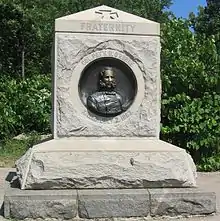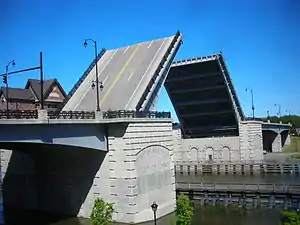Patrick O'Rorke
Patrick Henry "Paddy" O'Rorke or O'Rourke[1] (March 25, 1837 – July 2, 1863) was an Irish-American immigrant who became a colonel in the Union Army during the American Civil War and was killed at the Battle of Gettysburg.
Patrick Henry O'Rorke | |
|---|---|
 | |
| Born | March 25, 1837 County Cavan, Ireland |
| Died | July 2, 1863 (aged 26) Gettysburg, Pennsylvania |
| Place of burial | |
| Allegiance | |
| Service/ | |
| Years of service | 1861–1863 |
| Rank | |
| Commands held | |
| Battles/wars | |
| Signature | |

Early life
O'Rorke was born in County Cavan, Ireland on March 25, 1837.[2][3] He was a year old when his parents emigrated to the United States. In 1842, his family moved to Rochester, New York, where he attended the public schools.[4] In 1853, at age 16, he was awarded a scholarship to the University of Rochester; however, before attending college, his father died, and O'Rorke, to support his family, took a job as a marble cutter at the request of his mother.[2][3][4]
In 1857, he was appointed a cadet in the U.S. Military Academy at West Point, graduating first in his class in June 1861.The same class as George Armstrong Custer, who would graduate last.[5] He was then commissioned to the Corps of Engineers as second lieutenant.[6]
Civil War
In July 1861, O'Rorke served at the Battle of Blackburn's Ford and the First Battle of Bull Run, where his horse was killed from under him, and then as assistant engineer in preparing the defenses of Washington, D.C.[3][6][7] He sailed with the Port Royal Expedition[6][8] in October 1861 and provided vital reconnaissance[9] and engineering in constructing the batteries on Jones,[10] Bird,[11] and Tybee Islands for the bombardment and siege of Fort Pulaski, on Cockspur Island near Savannah, Georgia. Following the capture of the fort on April 11, 1862, O'Rorke was selected as one of the officers to receive the surrender.[3]
Following the battle, O'Rorke returned to Rochester where he was married on July 9 to Clara Bishop.[12][13]
In September 1862, O'Rorke was appointed colonel of the 140th New York Infantry which was composed mostly of volunteers from his hometown of Rochester and heavily of fellow Irish-Americans. He led the 140th New York in the Battle of Fredericksburg in December.[4] At Chancellorsville in May 1863, he temporarily commanded the 3rd Brigade, 2nd Division, V Corps which included the 140th New York, as well as the 5th New York and the 146th New York.
At Gettysburg, O'Rorke was back in command of his regiment while Brig. Gen. Stephen H. Weed commanded the 3rd Brigade. The 140th New York arrived in time for the second day of fighting (July 2, 1863). Brig. Gen. Gouverneur K. Warren was desperately searching for units to defend Little Round Top, and he encountered O'Rorke's New Yorkers, the rearmost regiment in Weed's brigade, on their way to reinforce the III Corps. O'Rorke initially declined Warren's request for assistance because he was under orders to follow his brigade. Warren told him, "Never mind that, Paddy. Bring them up on the double-quick and don't stop for aligning. I'll take the responsibility."[14] O'Rorke rushed his men to the crest of the hill and plunged down its western face without pause, driving the attacking Confederates back down the slope. During the counterattack, O'Rorke caught up his regimental colors and, mounting a rock to urge on his men, was struck in the neck and fell dead. The Comte de Paris in his Histoire de la guerre civile en Amérique (VI, iv, 379) says this was one of the most striking and dramatic episodes of the battle. A decorated member of O'Rorke's command, Lieutenant Porter Farley, in his noted work An Unvarnished Tale: The Public and Private Civil War Writings of Porter Farley, described O'Rorke's action on Little Round Top as among the most instrumental of the entire civil war, and many respected military historians have further commented that O'Rorke's service, heroism and selflessness, at such critical time in the battle, were at least equal to that of the much better known, Congressional Medal of Honor recipient, Joshua Lawrence Chamberlain.[15]
Burials and funeral
O'Rorke was initially buried by members of the 140 New York near Gettysburg alongside General Weed. However, on about what would have been their first anniversary, O'Rorke's widow Clara traveled to retrieve the body and it was returned by train to Rochester.[13]
A funeral for Colonel O'Rorke was held on July 15 in Rochester drawing hundreds of attendees, both Catholic and Protestant and across a range of ethnic groups. The event is credited with bringing unity to the community.[16] He was initially laid to rest in a Catholic cemetery on Pinnacle Hill,[12][13] but was ultimately interred in the Holy Sepulchre Cemetery in Rochester.[17]
O'Rorke's widow became a member of the Society of the Sacred Heart[3] and one of the most successful educators in its New York convents.[12][13]
In memoriam
After the war, Rochester area veterans founded O'Rorke Post 1 of the Grand Army of the Republic veterans society, the second post formed for the society.[18]
In 1889, New York erected a monument to the 140th Infantry on Little Round Top. The front of the monument bears a relief image of O'Rorke.[19][20]
In 2004, a bascule bridge in Charlotte (Rochester), New York, known as the O'Rorke Bridge, was dedicated to the memory of Colonel O'Rorke.[21]
References
- Although most Civil War sources spell his surname O'Rorke, O'Rourke is a common alternative spelling in Ireland. Both O'Rorke and O'Rourke appear for the family in the Rochester City Directory depending on the year and both spellings were used, for example, in General Tyler's report.
- Herbermann, Charles George; Edward Aloysius Pace; Condé Bénoist Pallen; Thomas Joseph Shahan; John Joseph Wynne (1913). "O'Rorke". The Catholic Encyclopedia. 11: 321–2. Retrieved 2012-01-01.
- Wilson, James Grant; John Fiske (1888). "O'RORKE, Patrick Henry". Appletons' Cyclopaedia of American Biography. IV: 591–2. Retrieved 2 January 2012.
- McKelvey, Black (1957). "The Irish in Rochester A Historical Retrospect" (PDF). Rochester History. XIX (4): 8. Retrieved 2012-01-01.
- United States Military Academy (1873). Official Register of Officers and Cadets of the United States Military Academy, West Point, New York, 1818-1873. United States Military Academy Print. p. 651.
- New York State Historian (1897). Annual report of the State Historian, Volume 1. Wynkoop, Hallenbeck Crawford Co., state printers. p. 64.
- "GEN. TYLER'S OFFICIAL REPORT". New York Times. August 11, 1861. Retrieved 2 January 2012.
- "THE GREAT NAVAL EXPEDITION.; EMBARKATION OF TROOPS AT ANNAPOLIS. Number and Names of Regiments. List of Men-of-War, Gunboats, and Transports.Departure from Annapolis and Return to Anchorage in Consequence of a Storm.From Our Special Correspondent". New York Times. Oct 26, 1861. Retrieved 2 January 2012.
- "OUR PORT ROYAL CORRESPONDENCE.; Important Events of a Few Days The Reconnoissances on the Mainland The Country Deserted by the Whites, from Tybee to Charleston Quantities of Clothes Discovered Fortifications Deserted The Negroes Welcoming the Union Soldiers". New York Times. Dec 7, 1861. Retrieved 2 January 2012.
- "FROM THE SOUTHERN COAST.; Details of Operations Against Savannah. THE RIVER BLOCKADED. REPULSE OF TATNALL'S FLEET. Experiences of a Flag of Truce from Beaufort. Literary Treasures En Route for the North. THE CONTRABAND QUESTION". New York Times. February 24, 1862. Retrieved 2 January 2012.
- "IMPORTANT FROM PORT ROYAL.; Arrival of the Ericsson with Another Installment of Cotton, IMPORTANT MOVEMENTS ON FOOT. Erection of a New Battery on the Savannah River. FORT PULASKI ENTIRELY INVESTED. Brunswick, Ga., Evacuated by the Rebels. OUR PORT ROYAL CORRESPONDENCE. ANOTHER BATTERY ON THE SAVANNAH ALARM AMONG THE REBELS TOPOGRAPHY OF THE RIVER BANKS OCCUPATION OF NORTH EDISTO THE NEWS FROM THE NORTH. FROM ANOTHER CORRESPONDENT. THE GUNBOAT VARUNA A MOVEMENT TO THE SOUTH. BRUNSWICK, GEORGIA". New York Times. March 6, 1862. Retrieved 2 January 2012.
- "Col. Patrick Henry O'Rorke". Archived from the original on 5 March 2007. Retrieved 3 January 2012.
- Bennett, Brian. "Paddy O'Rorke". Retrieved 3 January 2012.
- Clark, p. 84.
- http://www.irishfreedom.net/Articles/O'Rourke%20at%20Gettysburg.htm
- Fisher, Donald M. (1991). "The Civil War Draft in Rochester Part Two" (PDF). Rochester History. LIII (2): 4. Retrieved 2009-06-12.
- Vogt, E. Robert (2005). "Holy Sepulchre Cemetery" (PDF). Rochester History. LXVII (2): 27. Retrieved 2012-01-01.
- Fisher, Donald M. (1991). "The Civil War Draft in Rochester Part Two" (PDF). Rochester History. LIII (2): 22. Retrieved 2009-06-12.
- "140th New York Infantry Regiment". Retrieved 4 January 2012.
- Boltz, Martha M. (9 March 2010). "Col. Patrick O'Rorke: Gettysburg's famous Irish hero". Washington Times. Retrieved 4 January 2012.
- "O'Rourke Memorial Bridge in Rochester, NY". YouTube. Retrieved 2010-06-06.
Further reading
- Clark, Champ, and the Editors of Time-Life Books, Gettysburg: The Confederate High Tide, Time-Life Books, 1985, ISBN 0-8094-4758-4.
 This article incorporates text from a publication now in the public domain: Herbermann, Charles, ed. (1913). "Patrick Henry O'Rorke". Catholic Encyclopedia. New York: Robert Appleton Company.
This article incorporates text from a publication now in the public domain: Herbermann, Charles, ed. (1913). "Patrick Henry O'Rorke". Catholic Encyclopedia. New York: Robert Appleton Company.
External links
| Wikimedia Commons has media related to Patrick O'Rorke. |
